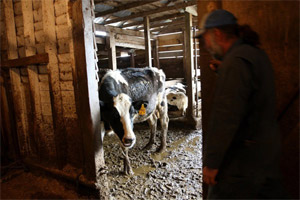[ Click here to view the visual essay ]
The Bernstein family schedules their week around hockey practice, Hebrew school, gymnastics, basketball, and trips to Target. Parents Cindy and Gregg work in tandem to ensure daily routines run as planned for their three young sons and golden retriever, Cain. But Cain isn’t your average house dog; the Bernstein’s sons — Gage, six, Cooper, four, and Reilly, three — have all been diagnosed with autism, and Cain is the service dog they adopted in April of 2008 to help the boys navigate the world around them.
Cain spent 15 months in training that has prepared him to work with children with autism spectrum disorders (ASDs), a set of developmental disabilities characterized by difficulties in social interaction, communication, and unusual or repetitive behaviors. ASDs can impact all aspects of life and vary from person to person. Connecting with others and reading social cues and body language is often difficult, and the development of verbal abilities may be delayed. Everyday sensory experiences (such as eating foods with different textures or getting a haircut) can be overwhelming, while other sensory inputs (such as deep pressure contact) might have a calming effect.
The relationship between a child and his service dog is unique and takes time to develop. Cain works mainly with Cooper and provides a sense of constancy as he accompanies Cooper throughout the day. Cain was trained to remain near Cooper when the boy’s behavior and stress level escalates.
“You can tell that Cain knows he’s here for Cooper,” says Gregg. “When [Cain] has his working vest on, he knows the deal.”
Autism service dogs also assist with social skills and communication. When other children have questions about Cain, the Bernsteins direct them to Cooper, encouraging their son to interact.
Adopting Cain was just one of the ways the Bernsteins work to provide services for their three sons. By the time each boy was two years old, they were all attending the Margaret Murphy Center, where they receive specialized education and support (Gage has since transitioned to public school). Additionally, Cindy and Gregg coordinate in-home therapy, and they use tools to help their sons navigate everyday social interactions and learn to express themselves appropriately. Regular team meetings with teachers, case managers, occupational therapists, and other professionals keep everyone up-to-date with the boys’ struggles and achievements.
Jennifer Marie Leahy
Dear Reader,
In The Fray is a nonprofit staffed by volunteers. If you liked this piece, could you
please donate $10? If you want to help, you can also:




